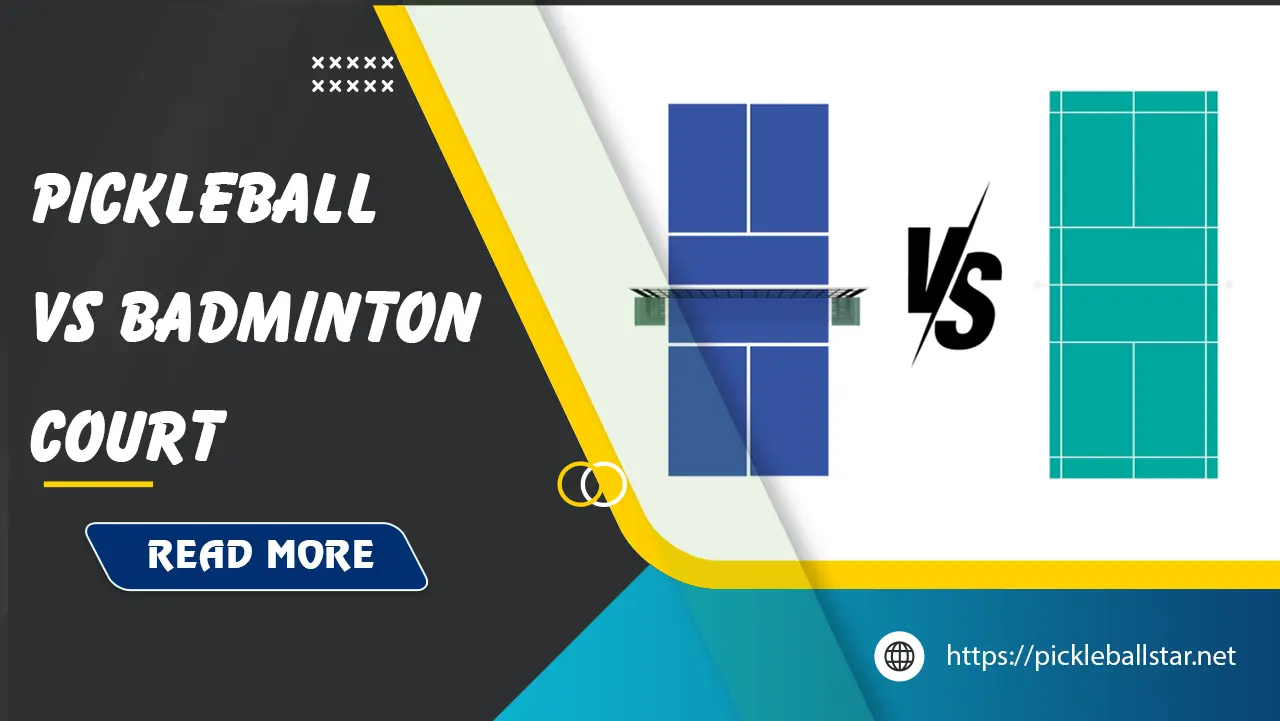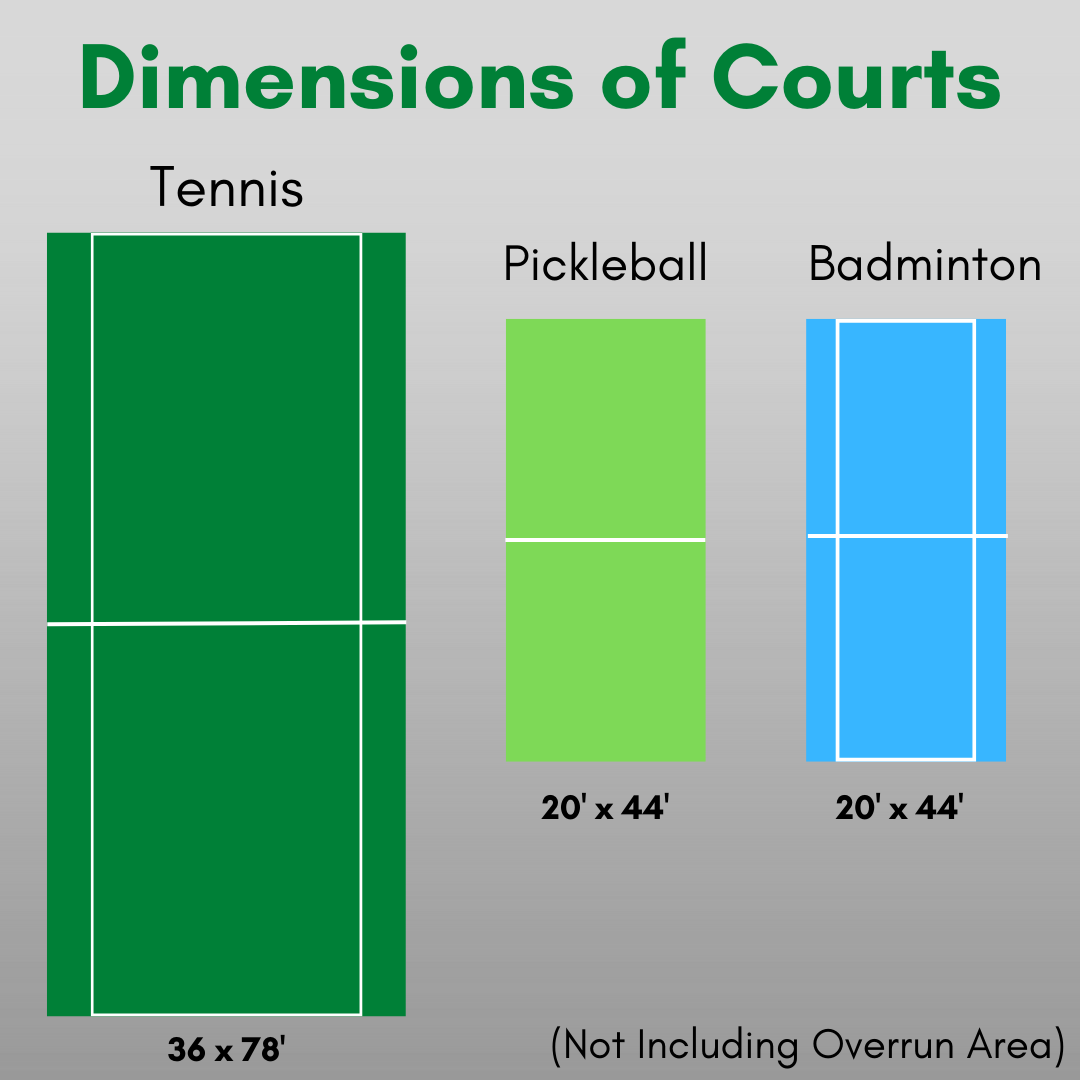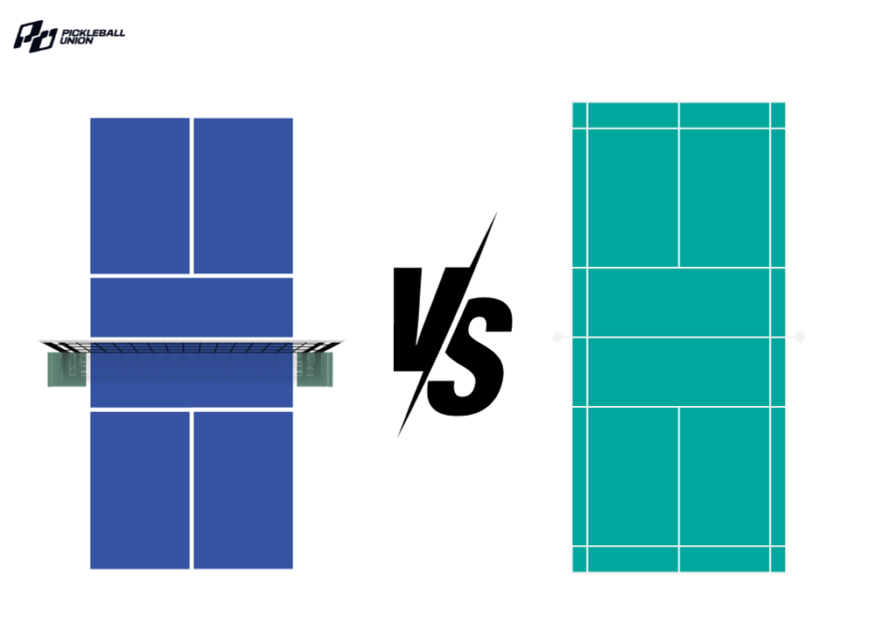Pickleball Court vs Badminton Court: An In-Depth Comparison
When it comes to racquet sports, the dimensions of the court play a vital role in how each game is played. Two such sports, pickleball and badminton, might seem similar at first glance, but the intricacies of their courts reveal notable differences that affect gameplay profoundly. Understanding these differences not only enhances your appreciation of both games but also helps in improving your skills. You might ask, “Are there other racquet sports that share similar court dimensions?” The answer is yes, but no two courts are exactly the same, and these subtle distinctions can shape the athletic experience. Discover the key differences between a pickleball court vs badminton court in this article.

Pickleball Court Dimensions
What are the specific measurements for a standard pickleball court used in doubles play?
The dimensions of a standard pickleball court used in doubles play are 20 feet by 44 feet. These measurements are the same for singles play as well. However, it is essential to note the presence of the non-volley zone, also known as the “kitchen,” which adds a unique element to the game.

How does the singles court in pickleball differ from the doubles court?
In pickleball, the court dimensions remain the same for both singles and doubles play, which is in stark contrast to other racquet sports such as tennis and badminton. The primary difference lies not in the court itself but rather in the strategies and dynamics employed by the players. The compact size ensures that movement and quick reflexes are pivotal, regardless of the number of players on the court.
Readmore: Pickleball court vs Tennis court
What is the significance of the non-volley zone in pickleball?
The non-volley zone, or kitchen, is a critical area located 7 feet from each side of the net. Players are not allowed to volley the ball while standing within this zone. This rule encourages tactical play and prevents overpowering shots from dominating the game. The concept of the kitchen emphasizes finesse and precision over brute strength, fostering a game that can be enjoyed by players of all ages.
Are there any variations in pickleball court dimensions depending on the level of play or the type of tournament?
For the most part, the dimensions of pickleball courts remain consistent across different levels of play and types of tournaments. However, temporary courts set up on existing surfaces, such as tennis courts, may introduce minor deviations. Regardless, these slight modifications do not substantially alter the essence of the game, ensuring a standardized experience for pickleball enthusiasts.
Badminton Court Dimensions
Why does badminton not have a non-volley zone?
Unlike pickleball, badminton does not feature a non-volley zone. This absence allows players to execute powerful smashes and quick net kills, contributing to the sport’s fast-paced and exhilarating nature. In badminton, the absence of such a restriction enables aggressive play and rapid exchanges, making it a spectacle of agility and precision.
Are the dimensions of a badminton court always the same, regardless of doubles or singles play?
One key aspect of badminton is the difference in court dimensions for singles and doubles play:
- Singles court: Typically measures 17 feet by 44 feet.
- Doubles court: Expands to 20 feet by 44 feet.

While the length remains constant, the width is extended in doubles play to accommodate the extra players, which significantly impacts the tactics and spatial awareness required.
Is there any difference in badminton court dimensions depending on whether the game is played indoors or outdoors?
Badminton courts are generally standardized, whether the game is played indoors or outdoors. However, outdoor play introduces additional elements like wind and uneven ground, which can impact the gameplay. Indoor venues are hence preferred for professional and competitive matches, where controlled conditions ensure fair play and consistent performance.
Key Differences in Court Dimensions
How much smaller is a pickleball court compared to a badminton court?
When comparing the two directly, a pickleball court at 20 feet by 44 feet is smaller than a doubles badminton court, which measures 20 feet by 44 feet. The striking aspect is the non-volley zone in pickleball, which adds a layer of unique strategy not present in badminton.

What impact does the non-volley zone have on the strategic aspects of pickleball?
The non-volley zone, or kitchen, significantly impacts the strategic aspects of pickleball by limiting the areas from which players can smash the ball. This encourages softer, more tactical shots and places a premium on touch and placement over power. It’s a bit like a chess game on the court, where anticipating your opponent’s moves and setting traps becomes just as important as physical prowess.
How does the absence of a non-volley zone affect the gameplay in badminton?
In badminton, the absence of a non-volley zone means that players can use the entire court to execute their shots, whether it’s a powerful smash or a delicate drop shot. This freedom allows for a more aggressive style of play, with rapid exchanges and continuous back-and-forth action. It’s the difference between a race car and a sport utility vehicle one is built for speed and agility, the other for versatility and control.
Impact of Dimensions on Gameplay
How does the smaller court size in pickleball influence the speed and style of play?
The smaller court size in pickleball means that players are always just a step or two from the action, necessitating quick reflexes and split-second decision-making. This results in a game that, while less physically demanding than some racquet sports, requires intense focus and accuracy. The reduced space compresses the action, leading to longer rallies and a higher emphasis on strategic play.
What specific shots and strategies are more common in pickleball due to its court dimensions?
In pickleball, several shots and strategies become more prevalent due to the court dimensions:
- Dinks: Soft shots that land in the non-volley zone, forcing the opponent to approach and play a controlled return.
- Drop shots: Similar to dinks but executed from further back, aimed at catching the opponent off guard.
- Lobs: High, arcing shots designed to push the opponent towards the baseline, opening up the court.
These strategies leverage the smaller court to create opportunities for winning points through finesse rather than sheer power.
What advantages do players have in badminton due to the larger court size?
In badminton, the larger court size offers numerous advantages:
- Wide angles: The expansive width allows players to exploit angles and stretch their opponents.
- Power play: The absence of a non-volley zone means that smashes and rapid drives can be used effectively to overwhelm the opponent.
- Net play: The extended space at the net encourages quick reflexes and fast exchanges.
These factors combined create a game that’s as much about speed and power as it is about tactical ingenuity.
What types of shots and strategies are favored in badminton as a result of its dimensions?
In badminton, the larger court allows for a diverse range of shots and strategies:
- Smashes: These powerful downward shots are a mainstay, used to finish rallies and dominate exchanges.
- Clears: High, deep shots intended to push the opponent back, creating opportunities for net play.
- Drops: Gentle, controlled shots that just clear the net, forcing the opponent to move forward and retrieve.
These strategic elements highlight badminton’s blend of power, speed, and precision, distinguishing it from the more confined and tactical play seen in pickleball.
Frequently Asked Questions
Is it possible to play both pickleball and badminton on the same court?
While it is technically possible to play both pickleball and badminton on the same court, it would require strategic placement of lines and possibly temporary nets to accommodate the different dimensions and rules of each sport. However, this setup is generally not recommended for serious play due to the differences in net height and the specific needs of each sport.
What is the overall length of a badminton court?
The overall length of a badminton court is 44 feet. This measurement remains constant whether the game is played as singles or doubles, although the width varies as previously discussed.
Does pickleball require more finesse or speed than badminton?
Pickleball generally places a higher premium on finesse due to the smaller court size and the presence of the non-volley zone. The game encourages tactical dinking and precise placement over raw power. Badminton, on the other hand, relies more on speed and quick reflexes, with its larger court and absence of restrictive zones allowing for more aggressive play.
Which sport is generally considered to be faster-paced: pickleball or badminton?
While both sports require quick reflexes and can be intensely fast-paced, badminton is generally considered to be faster due to the speed of the shuttlecock and the aggressive style of play encouraged by the court’s dimensions. Pickleball, while fast in its own right, offers a different kind of challenge, emphasizing control and tactical play within a more confined space.
Conclusion
The key takeaways from comparing pickleball and badminton court dimensions reveal how such specifics can deeply influence the nature of a sport. Pickleball’s smaller size and unique non-volley zone foster a game of finesse and strategy, while badminton’s larger court and unrestricted play promote speed and power. These differences not only explain why some people prefer one sport over the other but also highlight the diverse skill sets each game develops.
As both sports continue to evolve, understanding court dimensions can provide insight into their future development, potentially leading to new strategies and adaptations. Whether you’re drawn to the delicate tactics of pickleball or the rapid exchanges of badminton, appreciating the nuances of each court adds a layer of depth to your sporting life.
In the end, the court dimensions serve as the stage upon which the drama of athletic competition unfolds, each with its own unique script and set of challenges, making both games endlessly fascinating and rewarding to play.
